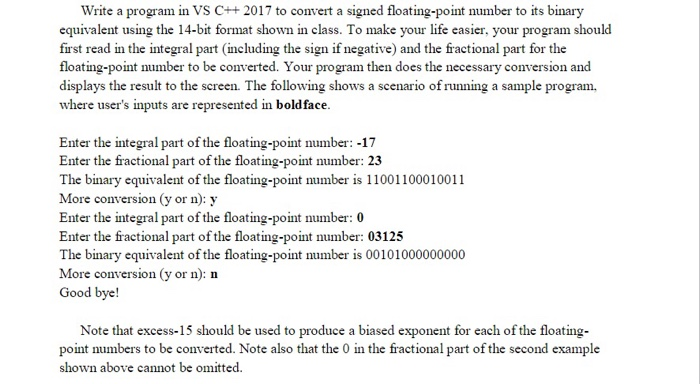write a program to convert a signed floating-point number to its binary equivalent using the 14-bit form

S C++ 2017 to convert a signed floating-poin Write a program in V equivalent usin first read in the integral part (including the sign if negative) and the fractional part for the flo at number to its binary g the 14-bit format shown in class. To make your life easier, your program should ating-point number to be converted. Your program then d displays the result to the screen. The following shows a scenario of running a sample program., where user's inputs are represented in boldface oes the necessary conversion and Enter the integral part of the floating-point Enter the fractional part of the floating-pointi The umber: -17 number: 23 binary equivalent of the floatin More conversion (y or n): y Enter the integral part of the floating-point i Enter the fractional part of the floating-point The g-point number is 11001100010011 umber: 0 number: 03125 binary equivalent of the fl More conversion (y or n): n Good bye! oating-point number is 00101000000000 Note that excess-15 should be used to produce a biased exponent for each of the floating point numbers to be converted. Note also that the 0 in the fractional part of the second example shown above cannot be omitted S C++ 2017 to convert a signed floating-poin Write a program in V equivalent usin first read in the integral part (including the sign if negative) and the fractional part for the flo at number to its binary g the 14-bit format shown in class. To make your life easier, your program should ating-point number to be converted. Your program then d displays the result to the screen. The following shows a scenario of running a sample program., where user's inputs are represented in boldface oes the necessary conversion and Enter the integral part of the floating-point Enter the fractional part of the floating-pointi The umber: -17 number: 23 binary equivalent of the floatin More conversion (y or n): y Enter the integral part of the floating-point i Enter the fractional part of the floating-point The g-point number is 11001100010011 umber: 0 number: 03125 binary equivalent of the fl More conversion (y or n): n Good bye! oating-point number is 00101000000000 Note that excess-15 should be used to produce a biased exponent for each of the floating point numbers to be converted. Note also that the 0 in the fractional part of the second example shown above cannot be omitted







